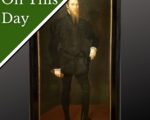
On this day in Tudor history, 1st August 1596, in the reign of Queen Elizabeth I, courtier John Ashley (Astley) died, probably at Maidstone in Kent. He was buried there at All Saints’ Church.
Here are some facts about Ashley
[Read More...]
On this day in Tudor history, 1st August 1596, in the reign of Queen Elizabeth I, courtier John Ashley (Astley) died, probably at Maidstone in Kent. He was buried there at All Saints’ Church.
Here are some facts about Ashley
[Read More...]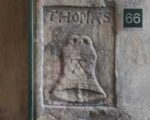
As yesterday was the anniversary of the martyrdom of Catholic Thomas Abell, on 30th July 1540, I thought he could be this week’s #MondayMartyr.
Here are some facts about this Henrician martyr:
– Thomas Abell’s birthdate is unknown but he’d been ordained as a Catholic priest by 1513.
– He studied at the University of Oxford, attaining a BA in 1514 and an MA in 1518.
– In 1522, Abell became rector at Great Berkhamsted in Hertfordshire…

On this day in Tudor history, 31st July 1549, in the reign of King Edward VI, Edmund Sheffield, 1st Baron Sheffield, was killed in Norwich.
Twenty-eight-year-old was serving in the royal force led by William Par, Marquess of Northampton, during Kett’s Rebellion in East Anglia.
They were trying to take Norwich back from the rebels, but suffered a brutal attack in the streets for the city. Apparently, Sheffield stumbled into a ditch and then was killed by a blow from a butcher named Fulke.
[Read More...]
On this day in Tudor history, 30th July 1563, in the reign of Queen Elizabeth I, writer and diarist Robert Parry was born at Tywysog in Denbighshire, North Wales.
Parry’s diary is a wonderful source for national events, as well as local events and family information. It is leather-bound and is decorated with gold letters R and P with a lion rampant. It opens with an entry about Parry’s birth and finishes in 1612.
[Read More...]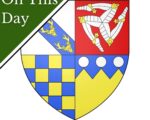
On this day in Tudor history, 29th July 1504, in the reign of his stepson King Henry VII, Thomas Stanley, 1st Earl of Derby, died at his manor of Lathom in Lancashire.
Here are a few facts about Stanley…
[Read More...]
On this day in Tudor history, 28th July 1540, after the execution of Thomas Cromwell, Walter Hungerford, Baron Hungerford of Heytesbury and a client of Cromwell, was beheaded on Tower Hill.
He was the only man in the Tudor period to be executed for “treason of buggery”.
[Read More...]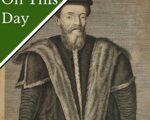
On this day in Tudor history, 27th (or 28th) July 1553, King Edward VI’s former tutor and principal secretary, thirty-nine-year-old Sir John Cheke, was sent to the Tower of London.
Edward VI had died on 6th July 1553 and his council followed his wishes, proclaiming Lady Jane Grey as Queen Jane…
[Read More...]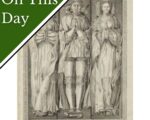
On this day in Tudor history, 26th July 1538, in the reign of King Henry VIII, George Talbot, 4th Earl of Shrewsbury and 4th Earl of Waterford, died at South Wingfield Manor, Derbyshire. He was buried at St Peter’s Church, Sheffield.
Here are a few facts about him…
[Read More...]
Fans of all things Tudor will be thrilled to know that a weekend conference dedicated to the late Dame Hilary Mantel’s Wolf Hall Trilogy will be held next summer
[Read More...]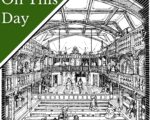
On this day in Tudor history, 25th July 1602, in the reign of Queen Elizabeth I, thirteen-year-old actor Salomon Pavy was buried at the Church of St Mary Somerset, near Blackfriars Theatre.
It is thought that Salomon was abducted to serve as an actor in the Children of Paul’s, for in 1601 when four men were accused of abducting another boy to serve as an actor, the name “Salmon Pavey, apprentice” was mentioned as a past abductee.
Salomon later joined the Children of the Queen’s Revels at the Blackfriars Theatre and had parts in plays by Ben Jonson.
[Read More...]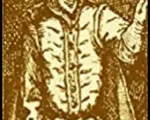
Today is the anniversary of the execution of Durham martyr John Boste in 1594, so I thought I’d share more details on Boste’s life and how he came to be martyred in Elizabeth I’s reign.
[Read More...]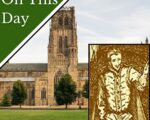
On this day in Tudor history, 24th July 1594, in the reign of Elizabeth I, Roman Catholic priest John Boste was hanged, drawn and quartered in Durham.
Boste had originally taken Church of England orders, but was converted to Catholicism in 1576. He travelled to the Low Countries in 1580 and travelled on to the English College at Rheims. He was ordained in March 1581
[Read More...]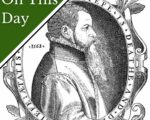
On this day in Tudor history, 23rd July 1584, in the reign of Queen Elizabeth I, Protestant printer, bookseller and publisher John Day died at Walden in Essex.
Suffolk-born Day was in London by 1540 working for printer and physician Thomas Raynalde. In 1546, he was awarded the freedom of the city of London and began printing in partnership with William Seres.
[Read More...]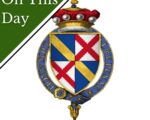
On this day in history, 22nd July 1437 (or 1438), soldier and royal councillor John Scrope, 5th Baron Scrope of Bolton, was born.
During the Wars of the Roses, Scrope was seriously injured at the Battle of Towton fighting on Edward IV’s side and in 1469 he sided with the Earl of Warwick against Edward, but was fortunately forgiven, even though he did that twice.
[Read More...]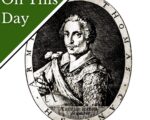
On this day in Tudor history, 21st July 1586, explorer, navigator and privateer, Thomas Cavendish, set sail from Plymouth on his South Sea voyage. He set off with three ships and 123 men.
[Read More...]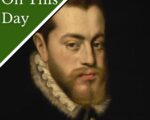
On this day in Tudor history, 20th July 1554, Philip of Spain arrived in England, at Southampton, in readiness for his marriage to Mary I.
Winchester Cathedral, seat of Bishop Stephen Gardiner, had been chosen as the wedding venue, due to the recent Wyatt’s Rebellion in London, and Mary and her court set off from Richmond on 16th June.
[Read More...]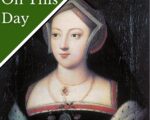
On this day in Tudor history, 19th July 1543, in the reign of King Henry VIII, Mary Boleyn died. It is not known where she was laid to rest.
Mary was the daughter of Thomas Boleyn, Earl of Wiltshire and Ormond, and his wife, Elizabeth Howard. She was the granddaughter of Thomas Howard, 2nd Duke of Norfolk, and sister of Queen Anne Boleyn and George Boleyn, Lord Rochford. At some point, she had been King Henry VIII’s mistress, but nothing is known of their relationship.
[Read More...]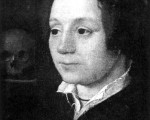
On this day in Tudor history, 18th July 1565, Katherine Ashley, or Astley, close friend and loyal servant of Queen Elizabeth I, died in London.
Katherine was the daughter of Sir Philip Champernowne of Modbury in Devon, and through him and her mother’s Carew family, was related to all the leading gentry in the West Country.
She joined Princess Elizabeth’s household in 1536 and served as governess. She married courtier John Ashley in around 1545. Their marriage was childless.
[Read More...]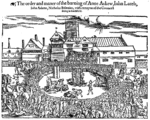
This week’s Monday Martyr is John Lascelles (Lassells, Lacels), a courtier who was burnt at the stake for his Protestant faith at Smithfield on 16th July 1546 with priest Nicholas Belenian, tailor John Adams, and famous Protestant martyr Anne Askew.
Here are some facts about this Henrician Protestant martyr
[Read More...]
On this day in history, 17th July 1537, Janet Douglas, Lady Glamis, was burnt to death for treason on the castle hill at Edinburgh.
Janet had been charged with plotting to poison King James V, nephew of King Henry VIII, and assisting and corresponding with her brothers, Sir George Douglas and Archibald Douglas, 6th Earl of Angus.
[Read More...]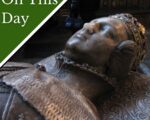
On this day in Tudor history, 16th July 1517, the feast of St Francis, Frances Brandon was born at Hatfield. She was the eldest daughter of Charles Brandon, Duke of Suffolk, and Mary Tudor, widow of King Louis XII of France and sister of Henry VIII.
Frances married Henry Grey, Marquis of Dorset (later Duke of Suffolk). They had three children: Jane, Katherine, and Mary.
[Read More...]
On this day in Tudor history, 15th July 1573, in the reign of Queen Elizabeth I, architect and theatre designer Inigo Jones was born in London.
Jones is known for founding, what the Encyclopaedia Britannica describes as the English classical tradition of architecture. He is mainly known for his design of the Banqueting House, which was begun in 1619, the Queen’s House at Greenwich, which was begun in 1616 and was built for Queen Anne, wife of James I, and his stage design work, some of it in collaboration with Ben Jonson.
[Read More...]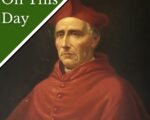
On this day in Tudor history, 14th July 1514, in the reign of King Henry VIII, Cardinal Christopher Bainbridge died in Rome of alleged poisoning. He was about 51 years old.
Bainbridge started his church career in Henry VII’s reign and became Archbishop of York in 1508. He was chosen as an executor of the king’s will.
[Read More...]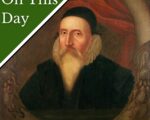
On this day in Tudor history, 13th July 1527, John Dee, the astrologer, mathematician, alchemist, antiquary, spy, philosopher, geographer and adviser to Elizabeth I and influential statesmen, was born in London.
He had an incredible career
[Read More...]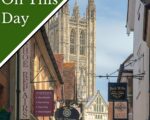
On this day in Tudor history, 12th July 1555, in the reign of Queen Mary I, preachers John Bland and John Frankesh, rector Nicholas Sheterden and vicar Humphrey Middleton were burned at Canterbury in Kent. They were all Protestants burned for heresy.
[Read More...]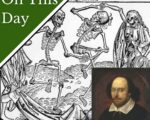
On this day in Tudor history, 11th July 1564, in the reign of Queen Elizabeth I, the first death from plague was recorded in the parish records of Stratford-upon-Avon, Warwickshire.
John Bretchgirdle, vicar of Holy Trinity, where William Shakespeare had been baptised that very year, on 26th April, recorded the death of Oliver Gunn, an apprentice weaver…
[Read More...]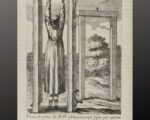
This week’s Monday Martyr is Catholic martyr John Cornelius, who was executed for treason, for being a priest and returning to England as a priest, on 3rd or 4th July 1594, in the reign of Queen Elizabeth I.
John Cornelius, who had Irish parents, was born in Bodmin in Cornwall in around 1557. Under the patronage of Sir John Arundell of Lanherne, Cornelius was educated at Oxford University, but was expelled due to his Catholic faith in August 1578. In 1579, he travelled to the English College at Rheims, in France, and then on to the English College in Rome, where he was ordained in 1583.
[Read More...]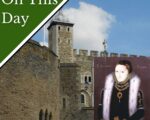
On this day in Tudor history, 10th July 1561, Queen Elizabeth I visited the Tower of London mint to check on the progress of her new coins.
Debasement of coins had happened between 1544 and 1551, in the reigns of Henry VIII and Edward VI, when the government was looking to fund foreign wars. The ratio of precious metal to alloy was reduced, so more coinage could be produced more cheaply, with the government pocketing the profit.
[Read More...]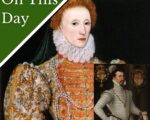
On this day in Tudor history, 9th July 1575, Elizabeth I began a stay at Kenilworth Castle, home of her favourite, Robert Dudley, Earl of Leicester.
Her 19-day-stay was recorded by Robert Langham, a member of Leicester’s household, and by poet and actor George Gascoigne, who was hired by Leicester to provide entertainment.
[Read More...]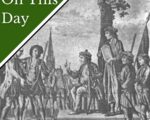
On this day in Tudor history, 8th July 1549, in the reign of King Edward VI, Kett’s Rebellion began.
Robert Kett, a Norfolk farmer, agreed to lead a group of protesters who were angry with the enclosure of common land. The protesters marched on Norwich, and by the time they reached the city walls, it is said that they numbered around 16,000.
[Read More...]